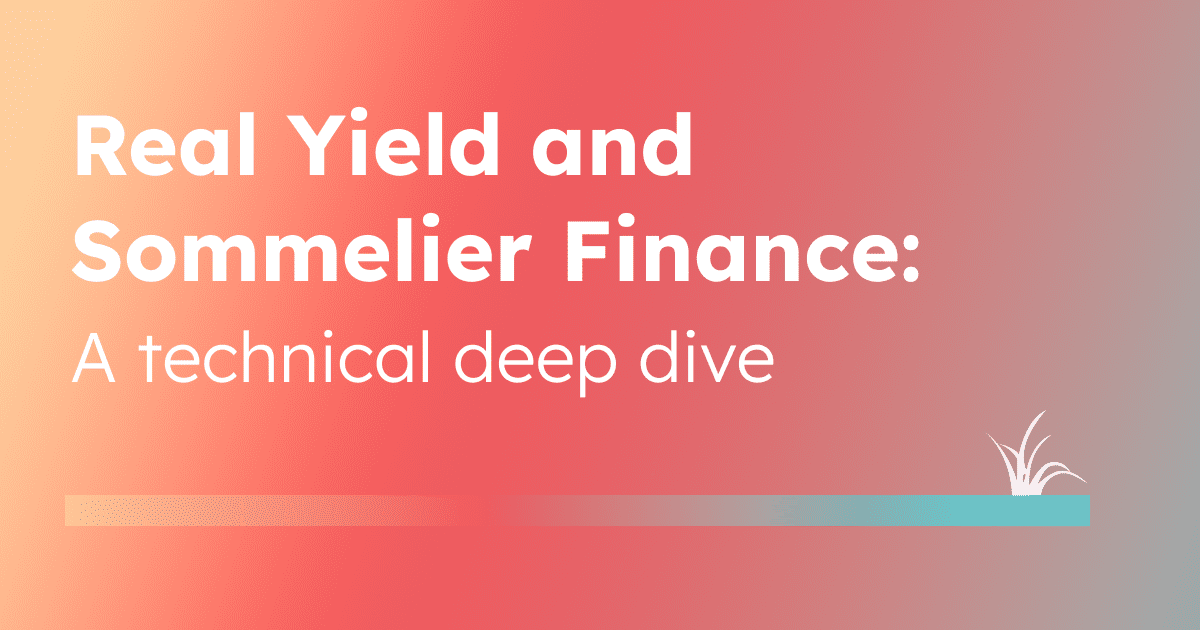If you want to explore the strategy yourself, you can click below to go straight into the opportunity.
Ok, on with the post…
What’s the top line on Real Yield?
Real Yield USD is a stablecoin yield optimisation strategy made available on the Ethereum blockchain, using smart contracts backed by active off-chain analysis, and voted on within Cosmos.
The strategy has been developed by analysts at Seven Seas Finance for the last six months. It aims to answer the question ‘how do I maximise blue-chip stablecoin yields using only battle-tested protocols?’ Blue-chip stablecoins mean DAI, USDT, USDC, and battle-tested protocols mean Aave, Compound and UniSwap V3, all of which have received billions of dollars in TVL.
The strategy achieves its aim by lending stables on Aave and Compound and providing liquidity on UniSwap V3, utilising Uni’s ticks, or price ranges. Sommelier describes this last bit as the “secret sauce”, claiming it’s difficult for vaults to achieve without the Sommelier architecture, which allows for off-chain computation (see below). Tick optimisation requires responsive vaults that allow analysts to actively observe various conditions.
The name ‘Real Yield’ refers to the fact that income is earned through lending and LP fees in stables, rather than initial giveaways in the project’s native token (although rhino.fi users can also earn a launch boost, paid out in Sommelier’s native token, $SOMM. This boost does not affect the base APY).
Users are able to deposit and withdraw from the vault at any time, natively – using their regular wallet.
What’s the top line on Sommelier?
Sommelier is described as the next-gen version of Yearn, a blockchain that facilitates intelligent strategies that can predict, optimise, react and evolve.
Each vault is a smart contract, trained to work with an approved list of DeFi protocols. A DeFi strategist works with teams in the Sommelier ecosystem to create the contract, and then they run their model off-chain, with a group of 40 independent validators handling the day-to-day rebalancing.
If, say, the model tells the strategists it’s best to rebalance from an Aave to a Compound lending position, that message is then passed to the Sommelier validator set via an API. If two-thirds of the validator set reach consensus, it’s passed through the bridge to the smart contract, where it is executed.
The Sommelier blockchain, built using the Cosmos SDK, is specifically designed for decentralised asset management, although rebalance messages are transmitted to the vault smart contracts on Ethereum. Sommelier plans to go multi-chain in the near future, so rebalancing messages will hit smart contracts on specific chains such as Avalanche and Arbitrum.
What is a strategy?
A strategy can take many forms. For example, it might opportunistically buy a couple of tokens when the price trends are changing, look to find the best yield for a set of stablecoins, or allow users to earn more ETH through different ETH opportunities.
Ultimately, the strategy is driven by user needs. If a user has an objective, they can build a strategy. Anyone can submit their own proposal and smart contracts for a strategy via a governance proposal.
How are strategies developed?
Strategists typically create their strategies by interacting with the community and gauging demand, or seeing a potentially profitable opportunity.
The process for creating strategies is three-fold:
- The strategists propose their strategy to the community.
- Once passed, the strategy is back-tested.
- The smart contracts are deployed.
What makes Sommelier unique?
Unlike other vault providers, Sommelier’s vaults allow off-chain computation. In other words, vault creators can run models off-chain, look at off-chain indicators and use this data to inform rebalancing decisions, which are then passed to the validator set.
Other DeFi yield strategies embed all the logic in the smart contract. That’s good for visibility of the decision-making process, but it imposes limitations too. On-chain strategies cannot absorb machine learning or off-chain data sources, and there’s no incentives for creators to build complex strategies. On-chain vaults are also exposed to front-running risks.
It’s important to note here that, even though stuff happens off-chain, users can see the constraints that are baked into the smart contract code. For example, a stablecoin vault can’t go rogue and take arbitrary exposure to ETH, and this limitation is completely visible. The off-chain strategists are obliged to optimise within the contract’s constraints.
What are the safeguards?
All the vault smart contracts are audited by an independent third-party (Sommelier’s auditor of choice is Macro), and yield protocols can only be selected from an approved list, which only includes proven, recognised projects.
All vaults need to go through community governance. Before a vault is launched, the strategy provider will typically create a forum post to explain the vault, its purpose, back-test history and the provider’s qualifications – essentially making their case to the community.
When rebalancing, a strategist can only do what the smart contract allows them to do. So, for example, strategists can only acquire the assets permitted by the smart contract. In addition, the strategist is denied direct access to the smart contract – the only people that have access are the validators. They are the only ones that can execute actions, and every recommendation has to go to the validators first.
In fact, Sommelier believes its validation mechanism is a particular strength. Decisions are executed by the blockchain’s entire validation set, rather than a multi-sig with a limited number of signers; according to the Sommelier team, a three or five-member multi-sig doesn’t provide the same protection as 40 validators.
The validators run an API software programme to allow strategists to communicate, and can filter the instructions strategists are able to provide. If the strategist were to disappear for some reason, the validator has the ability to move funds back to normal positions, shut down the vault and allow users to withdraw.
How are the Real Yield vaults monetised?
Vaults collect fees, which stand at 0.5% for real yield. A portion of the fees goes to the vault creator, as they created the strategy and are making rebalancing recommendations, and a portion goes to the people staking Sommelier’s native token, SOMM, to secure the blockchain. This provides a non-inflatonary funding mechanism for staking rewards.
What are the risks of the strategy?
The risks are the same as any other opportunity based on smart contracts. These include:
- A smart contract hack. This happens extremely rarely, but it does happen.
- Lack of liquidity. Occasionally, users who invest in yield opportunities find they are unable to remove their funds due to lack of liquidity in the pool they have deposited into (although, as mentioned, Sommelier seeks to mitigate this opportunity by using only recognised lending and liquidity provider protocols).
- Impermanent loss. This is a type of opportunity cost which is particularly prevalent during times of volatility, when a token’s value changes dramatically on the open market and users earn less from their yield than they would have done by actively trading their assets. This blog post explains it all.
Please remember that, for all the safeguards in place, crypto is volatile and no opportunity is guaranteed to deliver profits. Be sure to do your own research and make a considered decision on whether to invest.
Anything else? Just ask us
Hit us up on Twitter or Discord and we’d be delighted to chat through Real Yield or any other opportunity in more detail.




